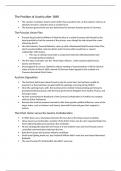The Position of Austria after 1848
The counter-revolution Austria went further than anywhere else, as the emperor ruled as an
absolute monarch, using the army as a police force.
The Austrian government was also determined to maintain Austrian power in Germany.
The Prussian Union Plan
Prussian king Frederick Wilhelm IV liked the idea of a united Germany with himself as the
head provided he had the consent of the princes, even though he had refused the crown
offered by the FP.
His chief minister, General Radowitz, came up with a Kleindeutschland Prussian Union Plan,
which would establish a German Reich under Prussia which would have a ‘special
relationship’ with Austria.
o This was an attempt to provide a compromise between Kleindeutschland and
Grossdeutschland solutions.
The first step in this plan was the ‘Three Kings’ Alliance’, which would include Prussia,
Saxony and Hanover.
Encouraged by its success, Radowitz called a meeting of representatives of all the German
states to Erfurt in March 1850, wherein 28 German stated agreed to the creation of a
Prussian-dominated Erfurt Union.
Austrian Opposition
The Austrians had known about Prussia’s plan for some time, but had been unable to
prevent it as they had been occupied with the uprisings occurring during 1848-9.
Once the uprisings had a with, the Austrian prime minister Schwarzenberg put forward a
grossdeutschland proposal, with Germany governed by delegates from Austria, Prussia, and
the larger states.
He then summoned the Bundesrat of the German Confederation in Frankfurt to compete
with the Erfurt Parliament.
Because the Austrian proposal seemed to offer them greater political influence, some of the
larger states, such as Hanover and Saxony, deserted Prussia and gave their support to
Austria.
The Erfurt Union versus the Austria Confederation
In 1850, there was a showdown between the two due to the Hesse-Cassel revolution.
Hesse-Cassel was technically a member of the Erfurt Union, but its ruler requested help from
the Frankfurt Bundesrat to put down the revolution.
HS was strategically important to Prussia as it was between east and west Prussian and so
controlled communications between the two.
Both the Prussian and Austrian militaries mobilised.
Small-scale fighting broke out, buy Frederick William didn’t want war and instead dismissed
Radowitz.
The new Prussian PM (Manteuffel) also didn’t want war.
, The Capitulation/Humiliation of Olmutz
A meeting between Manteuffel and Schwarzenberg in late November 1850 led to the
Capitulation/Humiliation of Olmutz, where the Prussian Union was abandoned.
However, Schwarzenberg’s next proposal for an Austrian-dominated ‘Middle-Europe’, which
would incorporate the 70 million people of all the German states and the Hapsburg empire,
was rejected as well.
Prussia and the smaller states preferred to return to the pre-1848 situation.
Therefore, in May 1851, the German Confederation was formally re-established and an
alliance between Prussia and Austria appeared to signal a return to the policy of close
cooperation.
That being said, many Prussians blamed Austria for the humiliate of Olmutz, and most were
totally against Austria’s ambitions to bring the entire Habsburg empire into the
Confederation.
Austrian Political, Economic, and Financial Problems
In the 1850s, the Austrian government made efforts to centralise the state, meaning:
o Control from Vienna by Germans.
o All civil servants, judges and army officers had to speak German.
This led to unrest amongst non-Germans in the Austrian empire.
The 1855 Concordat essentially made Catholicism the state religion of Austria, alienating
non-Catholic nationalities, German protestants and anti-clerical liberals.
Schwarzenberg’s attempts both to create a trade partnership with the Zollverein and create
a competing customs union failed.
Therefore, whilst Austria still had political leadership of the German Confederation, it was
effectively isolated from the Prussian-dominated economic coalition of the German states.
Austrian finances remained a serious problem, and were particularly damaged by the
Crimean war, and so had no way of reforming its army.
The Position of Prussia after 1848
Prussian Economic Success
Industrial production, railway building and foreign trade more than doubled in the 1850s.
The Zollverein helped Prussia trade with northern German states.
Prussia also had good natural resources – coal, iron, chemicals.
The railways were greatly developed.
There were also key individuals, such as Krupp (an iron and steel entrepreneur) who helped
the economy develop.
The Political Situation
After 1848, a new constitution was introduced that included universal male suffrage.
However, the Upper House remained aristocratic, the king controlled the army and had the
power of veto and the right to rule by decree, and the Lower House’s voting system was
based on the amount of tax that people paid and so was hardly democratic.
The Growth of Liberalism




